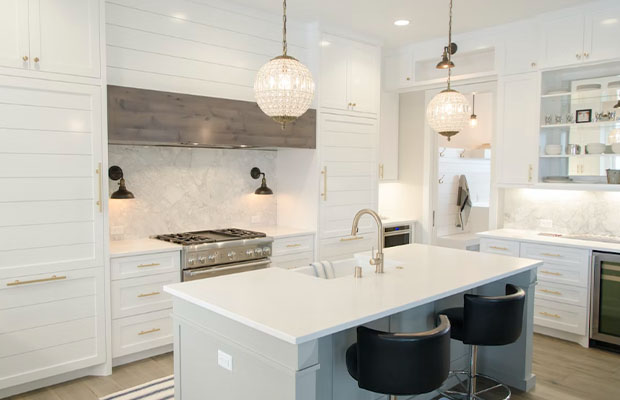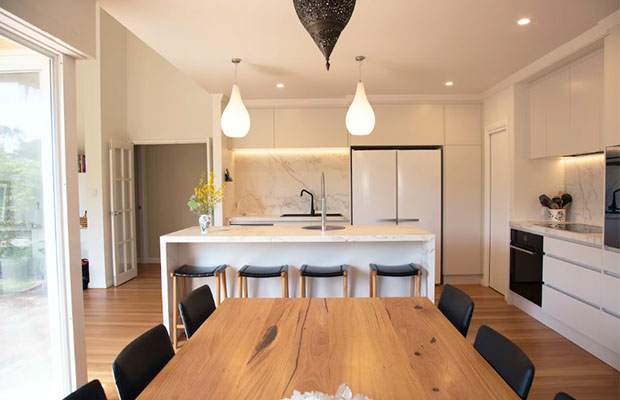Lighting fixtures are a crucial component of the process of getting your kitchen or dining room ready to start cooking. They not only provide the necessary lighting, but they can also help make the space feel warm and welcoming.
When they are in the same room, pairing kitchen island lights and dining room lights can be difficult. But don’t worry; we are here to assist.
To help you create the ideal ambiance for your culinary explorations, we’ll show you how to pair kitchen and dining lights in this guide.
What Do Kitchen And Dining Lights Work?
To make a room feel airy and welcoming, kitchen and dining lights are frequently used in tandem with one another. They can also be used to improve the appearance of certain rooms in your house, like the kitchen or dining room.
It’s important to think about your needs and preferences when selecting kitchen and dining lighting. You might, for instance, want to select elegantly subdued lighting over bright, upbeat options. Consider the type of light you are using for each task as well.
If you’re looking for kitchen and dining light sets, many retailers offer a wide range of choices. Additionally, there are individual lamps that can be used in the dining room or the kitchen. Budget and desired lighting style should both be taken into account when choosing these types of lights.
There are many resources online if you’re just starting to consider how to pair kitchen and dining lights. One excellent choice is to go to a store that specializes in selling lighting accessories and ask for assistance in selecting the ideal set of lights for your residence.
Different Types Of Lighting For Kitchens And Dining Rooms
There are a few different lighting options from which to choose when it comes to lighting your kitchen and dining room. Simple task lighting to opulent chandeliers is all examples of this. The most popular types of lighting for both spaces are listed below:
Task Lights
A standard light bulb will work if you only need a few task lights to assist with various tasks in your dining room or kitchen. These lights can be positioned wherever in the room you need a little extra lighting, such as close to where you intend to work or eat.
Table Lamps
Consider using table lamps if you need more than a few task lights. Larger kitchens and dining rooms benefit greatly from the substantial amount of light that these lamps can produce. They also come in a wide range of sizes and shapes, making it simple to match them to any decor.
Pendant Lights
Pendant lights are a great choice for hanging from the ceiling and are a great way to add a touch of elegance to the decor of your dining room or kitchen. Finding one that complements your style is simple because they are available in a variety of colors and styles.
Chandeliers
A chandelier is an ideal choice if elegance is what you’re after in your kitchen or dining area. It is simple to find the ideal fixture for your space because these fixtures are available in a wide range of styles and colors. Additionally, they can be quite pricey, so if you’re on a tight budget, make sure to think about other kinds of lighting instead.
Consider your individual tastes and preferences when selecting any type of lighting. The correct lighting selection is crucial if you want your dining area and kitchen to feel cozy and welcoming.

Tips To Pair Kitchen And Dining Lights
The contrast itself is beautiful. Interior designers shouldn’t use the exact same lighting fixture in both the kitchen and dining areas because it will look too uniform. Instead, design experts pick a variety of lighting fixtures that work well together. Strike the right balance by taking these three factors into account: surface area, finish, and form.
1. Surface Area: Kitchen Island To Kitchen Table
These days, it seems like almost every new house and kitchen remodel includes an island, the one thing your kitchen cannot live without. These must-have additions offer a great area for food preparation and double as a place to sit or a second buffet table when entertaining, but they are the most confusing when it comes to lighting.
If there is enough room, consider installing a trio of pendants for kitchen island lighting. Use energy-efficient, dimmable bulbs and, as a general rule, hang them 30-36″ above the island. Last but not least, consider style! Make sure they don’t obstruct your view or hang too low to accidentally hit someone in the head.
Additionally, keep in mind the breakfast nook and/or adjacent dining room (if visible from the kitchen) as you design your kitchen or reconsider an update to your lighting plan. Remember that they don’t have to be identical in terms of shape, but it’s usually a good idea to use fixtures that share the same color or material family. Make sure to keep in mind that there can only be one fixture front and center in terms of size and prominence when selecting fixtures for these coordinate areas.
2. Finish
Trying to achieve a more daring look? Use the same finish on various lighting styles. The finishes we like best for kitchen and dining lighting are listed below.
- Bronze – Lighting made of timeless bronze exudes warmth and beauty. Discover the two-tone Franklin Pendant or the ethereal, dark Ida Pendant if you like this style.
- Silver – Silver in all its forms—champagne, antiqued, vintage, and silver leaf—is something we adore. With the Clay Chandelier or Belfast Sconce, your kitchen will have an edgy feel.
- Gold– In a gourmet kitchen, in particular, gold instantly adds glitz. What could possibly be richer than gold, after all? Use Gabby’s Sandra Chandelier or Gracie Chandelier to achieve this look.
3. Form
When coordinating kitchen and dining lighting, look for similar lines. In order to create an eclectic look in your dining area and kitchen, you want both of these fixtures to be sufficiently different from one another while still complementing one another. Don’t forget to consider scale, either.
How To Choose Suitable Kitchen And Dining Lights?
Selecting the ideal dining and kitchen lighting is crucial if you want to brighten up your kitchen or dining area. You can choose the appropriate lights for your area by following these suggestions:
1. Consider The Lighting Needs Of Your Space
Make sure you are aware of the type of lighting needed for your kitchen and dining area before making any lighting decisions. In general, there are three main types of lighting in kitchens and dining rooms: task lighting, general illumination, and accent lighting.
Working in small spaces, like a kitchenette or below cabinets, benefits from task lighting. It provides just the right amount of light for working and is typically dimmer than other types of light.
Greater spaces, like kitchens or dining rooms, benefit greatly from general lighting. It can create a cozy atmosphere and is typically brighter than task light. Accent lighting can be used to draw attention to particular elements in a space, like a buffet or bar. Another benefit is that it makes a space sparkle even more.
2. Consider Your Budget
When choosing kitchen and dining lights, take your budget into account. Finding a light that suits your needs and price range is crucial because most lights come in a variety of price ranges.
3. Consider Your Space Style
Finally, when selecting kitchen and dining lights, consider the design of your space. Others are more subdued and ideal for smaller spaces. Some styles work better in light, airy spaces. Test out various lighting options in your area to see which ones are most effective for you.
Don’t worry if you’re still having trouble selecting the ideal set of kitchen and dining lights for your space; our staff at The Home Depot can assist you. You can reach us by phone or visit one of our stores right away!
Also Read: How is a Kitchen Island Attached to the Floor?
Conclusion
One of the most crucial factors to take into account when matching the lighting in your dining area and the kitchen is how each area is lit. Lighting fixtures can play a significant role in enhancing the mood and ambiance of your home in addition to lending a touch of glamour to your dining room or kitchen.
You can design a unified aesthetic for each of your spaces after reading our article. Don’t wait; get going now!
Other Posts You Might Like:


